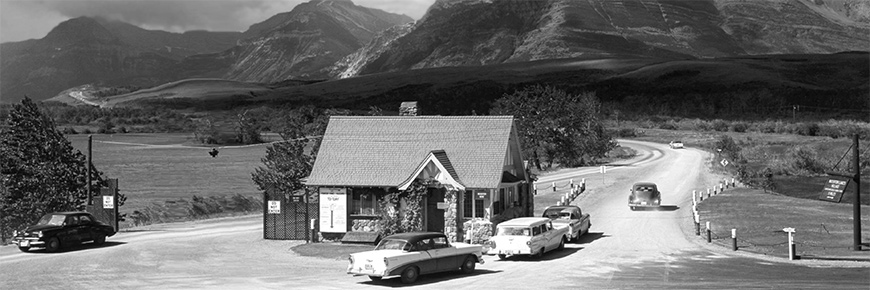
Park history
Waterton Lakes National Park
1890-1900
On May 30, 1895, a 140 sq. km (54 sq. miles) area was protected by the federal government as a Dominion Forest Park. Its status, boundary and name have varied over the years, and it is now known as Waterton Lakes National Park of Canada. Waterton was Canada's 4th national park and is the smallest in the Canadian Rockies 505 sq.km (195 sq. miles).
The first major step toward preservation of Waterton was taken by a Pincher Creek rancher, F.W. Godsal, who sent a proposal to Ottawa in 1893 recommending that the Waterton Lakes area be set aside as a protected area.

The park's name derives from the Waterton Lakes. This chain of lakes, named by Lieutenant Blakiston (a member of the Palliser Expedition), honours a British naturalist, Squire Charles Waterton (1782-1865).
1900-1910
John George 'Kootenai' Brown was the first settler in the park area, the first game guardian and fisheries inspector, and became the first park official in 1911.
In 1902, the first oil strike occurs, producing a flow of 300 barrels/day of high grade oil at "Original Discovery No.1" well site in Cameron Valley. In 1904, the Western Coal and Oil Company from Vancouver drills for oil near Cameron Falls, striking a flow of one barrel/day. They were responsible for the first settlement in the present village of Waterton Park, constructing a cookhouse, bunkhouse, blacksmith shop, office, stable and engine room.
In 1910, the first town lots were surveyed in the village. One hundred and fifty lots were offered for leaseholds at $15/annum rental for waterfront lots and $10/annum for back lots. The Hazzard Hotel (site of the present Bayshore Inn) and livery stable were two of the first town businesses.

1910-1940
In 1927, the Prince of Wales Hotel was opened and bus service to Glacier National Park (USA) began. The same year, a 250-passenger launch, the "M.V. International", is built and a year later begins operating on the upper lake. Visitors can still experience a boat tour of the Upper Waterton Lake on this historic vessel.
By 1931, the townsite had most modern facilities of the day, including a garage, golf course, tennis courts, campgrounds, post office, hotels, dance hall, a drugstore, 2 butcher shops, 5 restaurants, 2 churches, RCMP barracks, swimming pool, school, playground, telephone service and many summer cottages.
In 1932, the Waterton-Glacier International Peace Park was created to commemorate the peace, goodwill and cooperation between Canada and the U.S.A. The Peace Park is now both a symbol and a working example of positive cooperation in heritage management across boundaries.
In 1979, Waterton became Canada's second biosphere reserve and the first Canadian national park to take part in this UNESCO program. Biosphere Reserves are created to achieve a better understanding of the relationship between humans and the natural environment. Major goals are to support information exchange, research, education, training and improved land management; largely through cooperation and shared projects with local private landowners and other government agencies.

In 1995, the Waterton-Glacier International Peace Park was designated as a world heritage site.
The park has two National Historic Sites located within its boundaries: the First Oil Well in Western Canada NHS (designated in 1968) and the Prince of Wales Hotel NHS (designated in 1995).
The Prince of Wales Hotel opened its doors in Waterton Lakes National Park on July 25, 1927. The hotel stands isolated on a bluff overlooking a spectacular vista of mountains, lakes, town and prairie. Its striking design and dramatic setting make it Waterton's most recognized landmark.
In 1910, James Hill, president of the Great Northern Railway of the United States had a vision. He wanted to make Glacier and Waterton Lakes National Parks "the playground of the Northwest." With help from his son Louis, he designed and built a chain of hotels, camps, chalets, several boats, roads and trails to attract tourists to the area. To reach the parks they would ride the Great Northern. Louis Hill first visited Waterton in 1913 and selected the knoll overlooking the townsite and Upper Waterton Lake as the spot for the new hotel. The park's administration granted the newly formed Canadian Rockies Hotel Co. Ltd. a 42-year lease on February 1, 1926.

Constructed in 1926-27, the hotel became the sole Canadian link in this U.S. chain of resort hotels. Its soaring roofs, gables and balconies convey the appearance of a giant alpine chalet and enclose a magnificent timber-framed interior that continues to evoke the rustic atmosphere of mountain lodges built in that period.
Beginning in 1927, after arriving by train at either East or West Glacier, Montana, travellers began an exciting vacation using a variety of hotels, lodges and tent camps. They ended their trip with a ride aboard the MV International on Upper Waterton Lake from Goat Haunt, USA to Waterton Lakes National Park of Canada. They would spend an evening at the Prince of Wales Hotel before bussing back to Glacier National Park. This was one of many routes through the park supplied by the Great Northern, which were designed for the "affluent tourist," as one week's travel and accommodation could cost more than $1000-an enormous sum in the 1920s and 1930s.
Today, the Prince of Wales Hotel is a grand survivor from the golden age of railway resort development in Canada and the United States.
Related links
- Date modified :